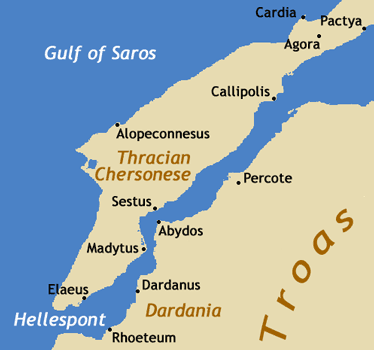.

Map of the Thracian Chersonese [Source]
The Thracian Chersonese (in Greek Χερσoνησoς Θραικια) was the ancient name of the Gallipoli peninsula, in the part of historic Thrace that is now part of modern Turkey.
The peninsula runs in a south-westerly direction into the Aegean Sea, between the Hellespont (now known as the Dardanelles) and the bay of Melas (today Saros bay). Near Agora it was protected by a wall running across its full breadth.1 The isthmus traversed by the wall was only 36 stadia in breadth2 (about 6.5 km), but the length of the peninsula from this wall to its southern extremity, Cape Mastusia, was 420 stadia3 (about 77.5 km).
History
The Thracian Chersonese was originally inhabited by Thracians. Settlers from Ancient Greece, mainly of Ionian and Aeolian stock, founded about 12 cities on the peninsula in the 7th century BC. 4 The Athenian statesman Miltiades the Elder founded a major Athenian colony there around 560 BC. He took authority over the entire peninsula, building up its defences against incursions from the mainland. It eventually passed to his nephew, the more famous Miltiades the Younger, around 524 BC. The peninsula was abandoned to the Persians in 493 BC after the outbreak of the Greco-Persian Wars (499–478 BC).
The Persians were eventually expelled, after which the peninsula was for a time ruled over by Athens, which enrolled it into the Delian League in 478 BC. The Athenians established a number of cleruchies on the Thracian Chersonese and sent an additional 1,000 settlers around 448 BC. Sparta gained control between 431 BC-404 BC, but the peninsula subsequently reverted to the Athenians. In the 4th century BC, the Thracian Chersonese became the focus of a bitter territorial dispute between Athens and Macedon, whose king Philip II sought possession. It was eventually ceded to Philip in 338 BC.
After the death of Philip's son Alexander the Great in 323 BC, the Thracian Chersonese became the object of contention among Alexander's successors. In 196 BC, the Seleucid king Antiochus III seized the peninsula. This alarmed the Greeks and prompted them to seek the aid of the Romans, who conquered the Thracian Chersonese, which they gave to their ally Eumenes II of Pergamon in 188 BC. At the extinction of the Attalid dynasty in 133 BC it passed again to the Romans, who from 129 BC administered it in the Roman province of Asia. It was subsequently made a state-owned territory (ager publicus) and during the reign of the emperor Caesar Augustus it was imperial property.
The Thracian Chersonese subsequently passed to the Byzantine Empire, which ruled it until the rise of the Ottoman Empire in the 14th century AD. In 1356 the peninsula became the first part of Europe to fall to the Ottomans, who subsequently made it a major base for raids and incursions into territories further afield.
Towns and economy
The principal towns of the Thracian Chersonese were Cardia, Pactya, Callipolis (Gallipoli), Alopeconnesus, Sestos, Madytus, and Elaeus. The peninsula was renowned for its wheat. It also benefited from its strategic importance on the main route between Europe and Asia; the city of Sestos was the main crossing-point on the Hellespont (Dardanelles). As well as its control of the shipping route from the Crimea, then known as the Tauric Chersonese.
References
Smith, William (editor); Dictionary of Greek and Roman Geography, "Chersonesus Thracica", London, (1854)
Notes
- Xenophon, Hellenica, iii. 2; Diodorus Siculus, Bibliotheca, xiv. 38; Pliny, Natural History, iv. 18; Agathias, Histories, v; Plutarch, Parallel Lives, "Pericles", 19
- Herodotus, The Histories, vi. 36; Xenophon, ibid.; Pseudo-Scylax, Periplus of Pseudo-Scylax, 67 (PDF)
- Herodotus, ibid.
- Herodotus, vi. 34; Cornelius Nepos, Lives of Eminent Commanders, "Miltiades", 1
--------------------------------------------------------------------------------
This article incorporates text from the public domain Dictionary of Greek and Roman Geography by William Smith (1857).
Greece :
A - B - C - D - E - F - G - H - I - J - K - L - M -
N - O - P - Q - R - S - T - U - V - W - X - Y - Z
| Ancient Greece
Science, Technology , Medicine , Warfare, , Biographies , Life , Cities/Places/Maps , Arts , Literature , Philosophy ,Olympics, Mythology , History , Images Medieval Greece / Byzantine Empire Science, Technology, Arts, , Warfare , Literature, Biographies, Icons, History Modern Greece Cities, Islands, Regions, Fauna/Flora ,Biographies , History , Warfare, Science/Technology, Literature, Music , Arts , Film/Actors , Sport , Fashion --- |
Retrieved from "http://en.wikipedia.org/"
All text is available under the terms of the GNU Free Documentation License


